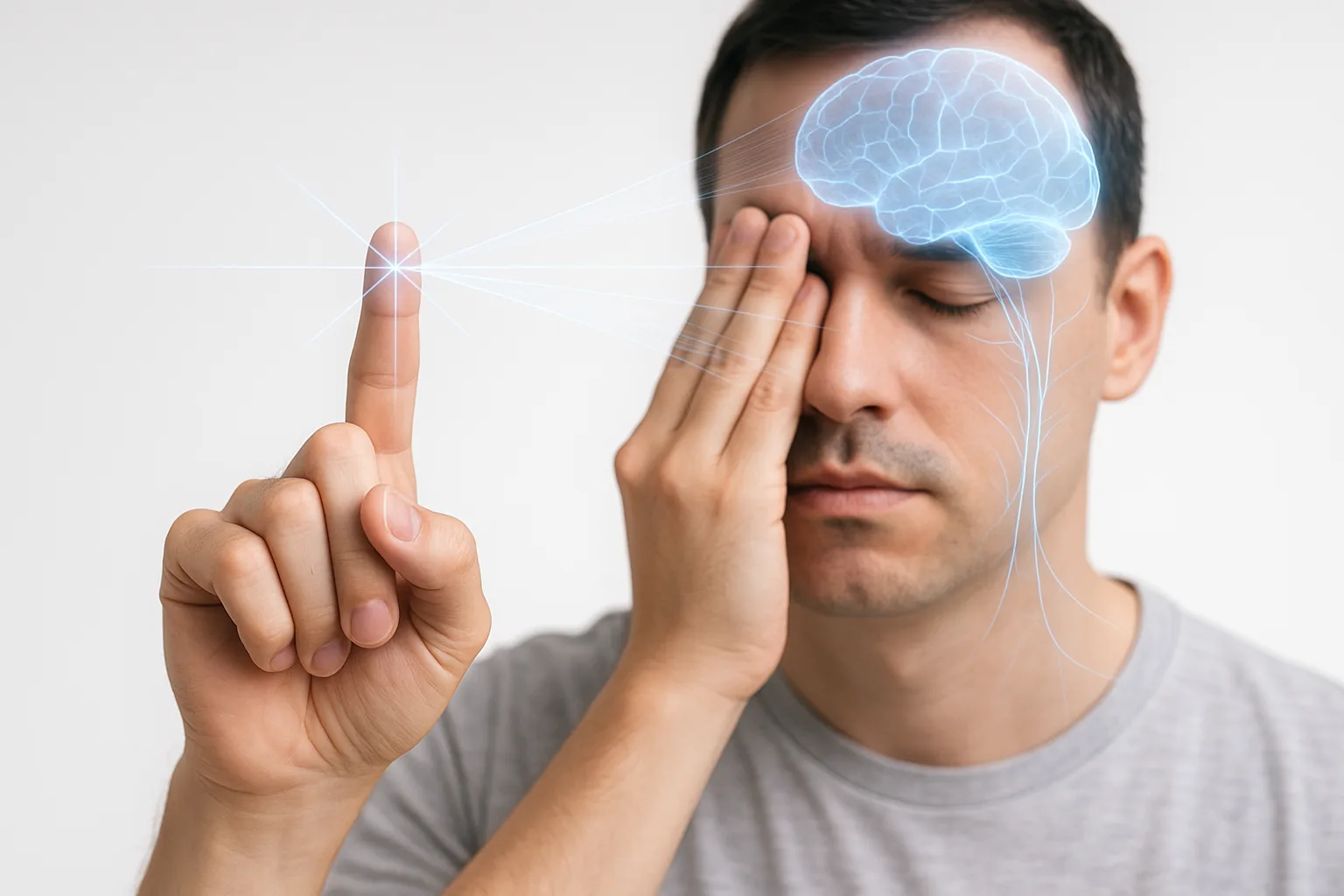Your brain receives two completely different images every second — one from each eye.
But you never notice this.
Instead, your brain blends both images into a single unified vision.
This vision switch test reveals how fast your brain merges conflicting information, how each eye competes for dominance, and how your brain edits reality without you ever knowing.
This is one of the most fascinating optical–neurological tests you can try at home.
Let’s begin.
Step 1 — Hold a Finger Between Your Eyes
Extend your arm and hold your finger at eye level, about 20–30 cm from your face.
Keep both eyes open.
Focus your gaze not on your finger, but on something behind it — a wall, door, or object several meters away.
What you’ll notice
Your finger becomes:
- doubled
- blurry
- semi-transparent
- floating oddly in space
This happens because your brain is receiving conflicting input from each eye — and instead of showing you two images, it tries to merge them.
This is the first stage of the vision switch test.
Step 2 — Switch Focus Instantly Between Near and Far
Now for the switch:
- Focus on your finger
- Then focus past your finger on the distant object
- Switch again
- Repeat 5–6 times
What you’re observing
Your vision snaps between:
- near clarity (finger sharp)
- far clarity (background sharp)
The “snap” is your brain switching attention, depth and visual dominance.
Your eye muscles tighten and relax extremely fast.
This switching speed is a sign of visual responsiveness.
Step 3 — Cover One Eye for 5 Seconds and Uncover It Quickly
Cover your left eye with your hand for exactly 5 seconds.
Keep your right eye focused on your finger.
Then uncover the left eye suddenly.
What you’ll notice
When you uncover the eye:
- the image might jump
- depth may shift
- one eye takes “control”
- double vision appears for a fraction of a second
- everything then blends smoothly
This shows how your brain fuses two different images into one seamless picture — a process called binocular fusion.
This is where the vision switch test becomes really interesting.
Step 4 — Repeat the Same Process With the Other Eye
Now:
- cover your right eye for 5 seconds
- keep your left eye focused
- uncover suddenly
Compare the results
You may notice:
- one eye blends faster
- one eye produces more double vision
- one eye regains depth perception more quickly
- one eye feels “dominant”
Your brain always prefers one eye — just like it prefers one hand.
This eye is called your dominant eye.

Step 5 — Test Depth Perception Response Speed
With both eyes open:
- Hold your finger in front of your face
- Move it slowly closer
- Then slowly farther
- Focus on it the whole time
What you’ll feel
Your eyes perform:
- rapid micro-adjustments
- simultaneous muscle tightening
- binocular depth recalibration
If you pay attention, you’ll sense tiny jumps in clarity.
This is your brain updating your 3D perception in real time.
This is the essence of the vision switch test.
Step 6 — Trigger Ocular Rivalry (Where Your Eyes Compete)
Here’s where things get REALLY interesting.
Do this:
- Hold a pen in front of your right eye
- Hold another object (like a finger) in front of your left eye
- Keep both eyes open
- Try to focus on both objects at once
What you’ll see
Your brain will:
- “choose” one object
- suppress the other
- then switch
- then blend
- then switch again
This is called binocular rivalry —
your brain literally selects which image wins.
This effect is extremely strong in the vision switch test.
Step 7 — Observe Visual Dominance by Changing Light Levels
Cover one eye partially with your hand so that a little light passes through.
Compare:
- clear eye
- dimmed eye
What happens
Your brain favors the brighter eye.
But when the dimmed eye moves or changes focus:
- the brain might switch
- then switch back
This reveals how visual processing isn’t only about clarity —
it’s also about brightness, contrast and motion.
Step 8 — Try the “Blink Fusion Test”
Look at a distant object.
Then:
- Blink your left eye repeatedly
- Blink your right eye repeatedly
- Blink both eyes alternately
What you’ll experience
During blinking:
- depth shifts
- perspective jumps
- image alternation happens
- the brain blends rapidly after each blink
This shows how fast your brain restores visual continuity —
even when input is disrupted multiple times per second.
The vision switch test demonstrates how powerful and adaptive this system is.
Step 9 — What This Experiment Reveals About You
This simple test provides unexpected insights into your visual brain.
1. Dominant eye
Your brain prefers one eye for clarity and control.
2. Fusion speed
How fast you merge two images into one.
3. Rivalry sensitivity
How quickly your brain switches preferred images.
4. Depth perception strength
How fast you detect distance accurately.
5. Muscle responsiveness
Your eye muscles may tighten faster on one side.
6. Light sensitivity
Your brain prioritizes brighter input.
7. Coordination
Smoothness = efficient brain-eye integration.
You just tested high-level visual processing in 30 seconds —
no tools required.
Try the Next 30-Second Experiment
The Breath-to-Heartbeat Sync Test — Feel Your Heart Rate Change with a Single Breath
